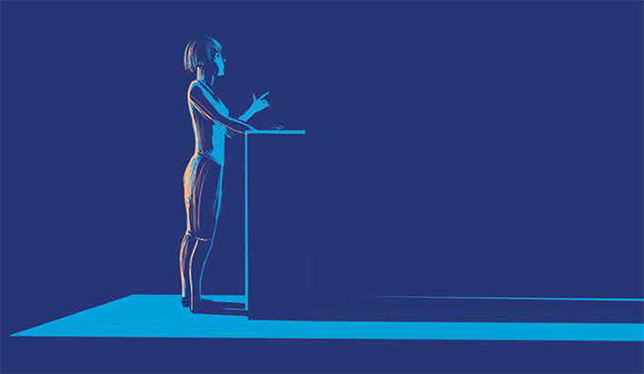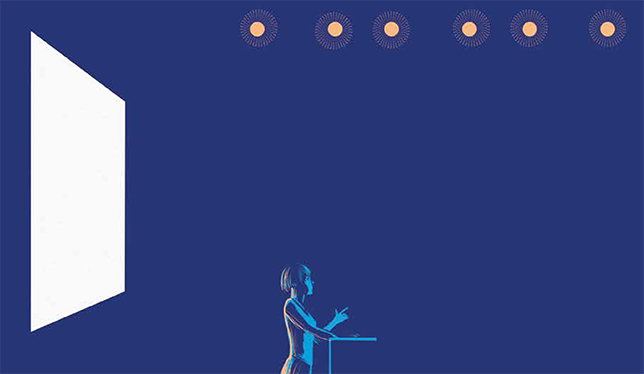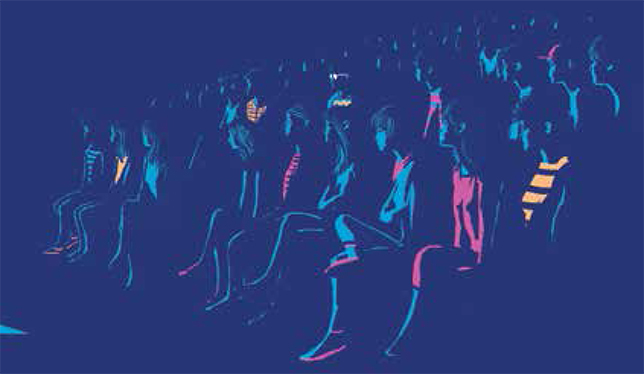A “teachable moment” is colloquially understood among educators as an unplanned moment that gives rise to a learning opportunity for students. Yet, often in these moments, teachers also learn something that changes the way they see their profession, their students or themselves. We invited the 2019 3M National Teaching Fellows to reflect on an occasion in their careers that enriched their understanding and practice of teaching. Here is a selection of their stories.
Bearing witness
Helga Thorson
What would you do if you witnessed someone giving a Nazi salute at the Holocaust memorial in Berlin? Or heard a group laughing loudly and disrespectfully on the sombre paths at Auschwitz-Birkenau? Or if your tour guide in Kraków, Poland, made an antisemitic joke? These are decisions my students and I had to make in real time during the University of Victoria’s I-witness field school on Holocaust memorialization, a course that involves one week of intensive study at UVic followed by three weeks visiting a variety of Holocaust memorial sites in three or four different countries in Europe.
For an instructor, it is not always easy to decide when and where to process these spontaneous “teaching moments,” especially on a field trip where we do not always have an available classroom. Whereas some people may choose to take action in these instances, others may feel it is not their place to get involved. Usually it is a split-second choice we make, and it changes from situation to situation.
It was on our first full day in Europe in 2014, when a group of UVic students observed an adolescent boy goose-stepping and giving the Nazi salute in front of a group of his classmates at a Holocaust memorial. They decided to act and approached a couple of the teachers who accompanied the boy’s school group. The two people the students spoke to denied that any of this had taken place.
In class the next day, when we discussed what had happened, the students were disappointed and confused, not only by the reaction they received from the people they had approached but also by the reaction of some of their classmates who maintained it was none of their business to get involved. Although such discussions do not often lead to resolution, they do build awareness and prompt reflection – reflection that may take years to process fully.
It is in such moments that field schools offer more than classrooms ever can. They are laboratories of life itself that guide us in figuring out the extent to which we want to be observers, bystanders or upstanders, and the contexts in which we may choose to act or choose to remain silent.
Dr. Thorson is an associate professor in the department of Germanic and Slavic studies at the University of Victoria.

Teaching, not telling
Sue Dawson
When I first started teaching, I fell into a mindset common to new teachers, which Joan Wink described well in the book Critical Pedagogy in 2004: “I will teach, and they will learn.” I thought that teaching would be a simple process: I would waltz into the lecture theatre and dispense my knowledge, teaching them everything they needed to know. As long as I covered it, I thought at the time, my students would learn it.
All went well until midterm exams approached. “What do I need to know for the exam?” my students would ask. “Do I need to know about innervation of the coracobrachialis muscle? Do I need to know about the function of the abductor hallucis longus muscle?” Hearing their questions, I felt frustrated. I realized that while I may have told them the content, they did not develop any meaningful understanding of its clinical significance. They had memorized a laundry list of structures rather than under-standing how the parts of the body are interrelated.
I needed to change what I was doing, because teaching is more than “telling.” Good teaching is not necessarily something I do to students. Rather, it is a mutual process of shared responsibility that we work through together. I needed not only to listen to my students but to involve them in constructing meaning from the content.
Veterinary students need to learn anatomy not simply to be able to name structures, but to have a three-dimensional working knowledge of where muscles and bones are located on the body, how blood vessels and nerves travel along and around bones, and what it will mean to the animal if any of these structures are damaged. They need to be able to do a physical exam on a dog, or horse, and know if what they are feeling is normal or abnormal.
If we imagine the body as a map of a city, meaningful knowledge of anatomy is knowing where the roads lead, where the landmarks are, and how to navigate around important places. Memorizing a list of all the roads in the city is certainly possible, but not meaningful. The questions students ask reflect their level of understanding, and listening to their questions guides me in my response. Instead of telling, I ask, and we have a conversation that can help build their own understanding.
Dr. Dawson is a professor in the Atlantic Veterinary College at the University of Prince Edward Island.
An excess of good intentions
Emin Civi
I teach marketing. The post-graduation job market is tough, so I’m always looking for ways to keep students up to date on marketing trends to prepare them for the real situations they will face in their jobs. But, sometimes the best intentions can go awry. One semester I came up with a new assignment to give students a practical understanding of how real companies implement the marketing principles in their textbook. For extra credit, they could read articles covering actual marketing practices of well-known companies. Their task was to comment on any three of the articles uploaded for each chapter.
Additionally, since I wanted students to see how others approach issues, I also asked them for remarks on any three commentaries written by their classmates. I got so excited by the learning potential of the articles I found that I kept adding more – and more and more – to the pool from which students could choose. This assignment was not mandatory, but I truly believed that most students would share my excitement about this novel learning activity and would want to read as many as possible of these wonderfully relevant articles.
As the semester ended, I was puzzled – and saddened – to discover that few students had written commentaries. Fortunately, my puzzlement was solved by student comments in the teaching evaluations that provided a valuable “eureka” teaching moment for me. As one student wrote with controlled exasperation, “Professor Civi has 396 things posted on [learning management system] D2L, it is extremely overwhelming and very difficult to keep up with.”
I got the point. The following semester, I chose only a few relevant articles and asked my students to discuss them in class. I had learned the lesson that providing excessive reading materials – however helpful – could produce the opposite effect, overwhelming and discouraging students to the point that they might actually disengage from me or the class. No matter how excited I am to provide new ways for my students to gain knowledge, I now always try to keep moderation and balance in mind.
Dr. Civi is a professor in the faculty of business administration at the University of New Brunswick.

The power to transform
Sheri Fabian
One of my greatest rewards is when students tell me that their learning experience led to a better understanding of themselves and their view of the world. It is no secret that teaching has the potential to transform both the educator and the student, and a few moments in my career continue to shape my role. One seemingly simple class activity I first used in 2008 turned into a transformative experience both for me and at least one student.
In my undergraduate seminar class on minorities and criminal justice, I started by asking students to close their eyes and then I went about the room placing stickers on their foreheads (I used five each of red, yellow, orange, green and blue happy-face stickers, with just one student getting a purple sticker). Students were then instructed to find their group with-out speaking or writing. Five groups quickly formed and, much to my surprise, the student with the purple sticker was physically pushed away and left alone. Admittedly, I hadn’t anticipated physical contact, nor was I prepared for the speed at which the groups formed. In our debrief after-wards, students reflected on the ease with which we exclude others based on difference (the colour of the stickers) instead of including them based on similarity (all stickers were round with happy faces).
After final grades for that course were released, one student, at her instructor’s urging, sent me a copy of a class assignment she’d submitted in another course. I started reading her paper with trepidation and had no idea that I was about to experience a transformative moment. Suddenly, I understood the power of teaching. This student, too, had been trans-formed by this exercise and the instructor in her education course knew I needed to understand the impact of what I’d done.
The student wrote: “The activity alone was worth more than any lecture that any scholar could have given about racism or discrimination. It was so simple and yet filled with so much content and it enriched the whole learning process.”
I now appreciate more the privileged position educators hold and I constantly remind myself that we are not always aware of these effects, good or bad. Although I continue to worry about the things I say or do that negatively impact students, I hope that, more often than not, the opportunities I offer my students inspire them to continuously grow, enhance their learning and facilitate their engagement with the world long after the classroom experience ends.
Dr. Fabian is a university lecturer in the school of criminology at Simon Fraser University and director of SFU’s Institute for the Study of Teaching and Learning in the Disciplines.
“Opened it once, but it seemed complicated”
Brett McCollum
One of my most memorable teaching moments happened in September 2012. I was using an icebreaker activity in my first-year undergraduate chemistry class, and it revealed a concerning and rather sudden change in the habits of my students compared with previous years. Normally, I would have a handful of students who admitted that they rarely read outside of class for enjoyment. That year it was about half of my class that reported they did not read for leisure at all! The next year, and since then, it has hovered around 70 percent of my students who report that they do not read for leisure.
Their reading habits also influenced their engagement with their course textbook. Students were returning their textbooks to the bookstore at the end of term still shrink-wrapped. When I asked them about the value of academic reading, responses included, “I opened it once, but it seemed complicated” and “reading is a waste of time.” At the same time, I observed that my students were less successful at applying concepts even when I demonstrated them through example problems. Instead, some more-vocal members of my classes would complain that my exams weren’t fair because “it wasn’t the same problem as in the lecture notes.”
My teaching evaluations indicated that students were pleased with my efforts to present the course concepts, but they were not developing an important academic skill: the ability to critically read academic texts. I looked in the education literature and found evidence that my students were deincentivized to read course materials, which I outlined in class with slides.
I took a year to reflect on what changes I would strategically implement as part of a systemic revision of my course materials and pedagogy. I adopted an open educational resource textbook available online, Libre-Texts, to eliminate access barriers. I also began using a partial flipped classroom model and found that even science students want to develop academic relationships with their peers. While it took some practise to get it right, the impact has been profound. Consistent pre-class reading has increased from three percent to 95 percent of students, and my students’ exam marks have increased in the range of 11 to 17 percent among my first-, second- and third-year courses. In my experience, thoughtful and strategic pedagogical redesign is worth the effort.
Dr. McCollum is a professor in the department of chemistry at Mount Royal University and is the chair of SoTL Canada, which promotes the scholarship of teaching and learning.

Deepening our connections
Sarah Todd
Some of my most memorable teaching moments have happened when I have led an introductory intensive course that the Carleton school of social work offers incoming graduate students. Near the end of the first week in the fall term, when the course usually takes place, I ask the students to engage in a community bundling exercise. It is an activity that I learned from colleagues in community work and integrated into the classroom. Its purpose is to facilitate students’ learning about how to build community by engaging in an activity that is intended to strengthen their own learning community.
I ask each student to bring in an item that is meaningful to them. We sit in a circle and each person tells a story about their item and places it on the blanket in the middle of the room. At the end of the exercise, we fold the items in the blanket and talk about the importance of being gentle with, and respectful of, these stories while in graduate school. It is part of an effort to create a more collaborative and supportive learning environment.
Every time the activity unfolds, I am confronted with how the students have important stories to tell, and that they are rich and textured people whom I will never fully know. I am reminded that we all carry stories that are central to how we relate to each other as learners and educators. Ultimately, the bundling exercise reminds me of the centrality of building community and relationships to facilitate learning between students, and between instructors and students. Each time I do this exercise with students, my assumptions about them are shattered and I watch as that realization happens with everyone in the room.
Through the bundling exercise, relationships among students that are often built on first impressions and luck, shift and new possibilities for connection and learning unfold. It centres what I see as the heart and soul of pedagogy – our ability to let students be seen so they can then open up their imaginations and transform. The learning that happens in the groups is palpably different after that exercise. Our connection to each other deep-ens and new possibilities for learning emerge.
Sarah Todd is a professor in the school of social work at Carleton University.
Letting students lead
Anne-Marie Ryan
Teaching has many moments that are memorable: when the AV equipment does not cooperate and you are faced with drawing on the board, in spite of your artistic ineptitude; when an alumna writes to let you know the profound impact of your course five years on; or that first time you don’t know the answer to a question and you fear being exposed for the impostor you now feel you are. I would like to share one moment that speaks to something my students taught me recently.
It was a regular Tuesday evening class later in the term, and the science leadership students would soon be graduates, embarking on the next stage of their journeys. On this evening as we sat together, it registered with me that I was doing all the leading. This seemed a bit incongruous: everything I believed about teaching and learning told me that students needed authentic practice with new ideas, yet here I was controlling the conversation. Without really thinking it through, I stopped the discussion and turned it over to the students to take turns leading the conversation around the readings they had done prior to class: would they accept, or would they turn again to me to lead? Or, worse still, would the conversation slip off the rails to irrelevance? Sounding more confident than I felt, I assured them that they were ready and able to take the lead – and take it they did. Without missing a beat, they took turns at facilitating a dynamic and rich discussion quite effortlessly with competence and confidence.
I wondered why I had not done this before. Although, to be honest, taking such an approach in a science class was decidedly risky, as science students are not in the habit of taking control of discussions and are more familiar functioning as passive receivers or, at best, formal presenters.
That evening shaped how I have come to view student agency. My students taught me it was OK for us to take calculated risks to improve the learning environment: to trust that when there is a community of learning developed in which mutual respect is built, students can and will rise to whatever challenges we set them.
Dr. Ryan is a university teaching fellow in the department of earth and environmental sciences, and faculty associate in the Centre for Teaching and Learning, at Dalhousie University.
Fantastic stories demonstrating passion for teaching and deep attention to the learner leading to subtle and profound changes in the practice of teaching! Canadians are proud of such outstanding teachers in our universities!
Baljit Singh
University of Calgary